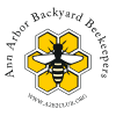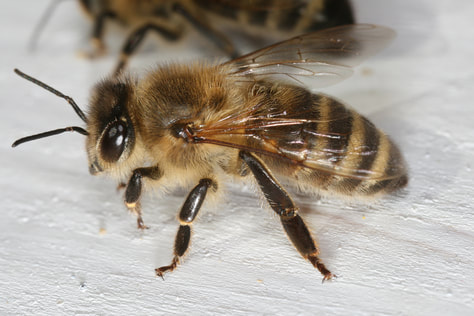 Almost All Worker bees are the sterile, female honey bees that make up the majority of the bees in the colony. They are hatched from fertilized eggs, so are diploid or have two sets of genes (one set from the queen and one from a drone the queen has mated with). They are the smallest bees in the hive. Busy As their name suggests, worker bees do all of the work in the hive. In the summer, workers live for about 5-6 weeks and spend roughly half their lives inside the hive and half outside the hive. A worker bee’s first task is to clean out the cell from which she emerged as an adult. Next, a worker will become a nurse bee, caring for and feeding the brood. There are many other tasks inside the hive such as comb-building, taking care of the queen (as part of the queen’s retinue), and storing nectar brought in by foragers, but not every worker bee will perform every task. The last half of a worker’s life is spent traveling outside the hive as a forager. Collectors Foragers are worker bees who leave the hive to gather resources. Foragers are specialized and will either forage water, pollen, nectar, or propolis (resin from trees). Nectar foragers exhibit floral fidelity, meaning they will only visit flowers of one species of plant on each foraging trip and often only one species the entire day. The species of flower chosen will depend on what’s in bloom. Foraging is dangerous and takes a lot of energy. Foragers are the oldest workers in the hive and will typically die on a final foraging trip. More Information: https://bee-health.extension.org/sequence-of-duties-of-worker-basic-bee-biology-for-beekeepers/
0 Comments
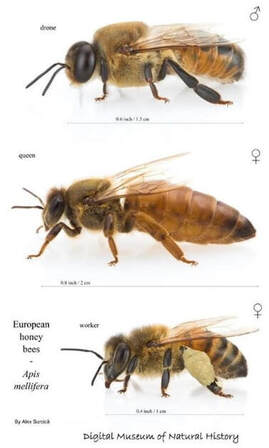 Source: http://www.waikatobeekeepers.org.nz/bee-information/bee-gallery/ Source: http://www.waikatobeekeepers.org.nz/bee-information/bee-gallery/ Annual There are not drones present in the hive all year long. In the late fall, the remaining drones are forced out of the hive and starve or freeze to death. The winter cluster of a honey bee colony therefore only contains workers and the queen bee. The queen lays new unfertilized eggs to replenish the drone population in the spring. Boy Drones are the male bees in a honey bee colony. They develop from unfertilized eggs and are therefore haploid or have only one set of genes that comes from the queen. In other words, drones do not have fathers, only grandfathers. Drone cells are larger than worker cells because drones are larger than worker bees and have larger eyes. Drones also take longer to develop into adults than workers (24 days vs 21 days). This is one reason Varroa mites prefer to reproduce in drone cells. Congregation Drones have one job, to find and mate with virgin queens. They do so in drone congregation areas (DCAs) which are specific sites in the air high off the ground used year after year. Drones from many local hives will visit the same DCA. Drones use their large eyes and powerful flight muscles to spot and catch a virgin queen out on her mating flight. When a drone mates with a queen, his sex organ (endophallus) will break off inside her and the drone will die. More Information: https://www.perfectbee.com/learn-about-bees/the-life-of-bees/role-of-the-drone-bee 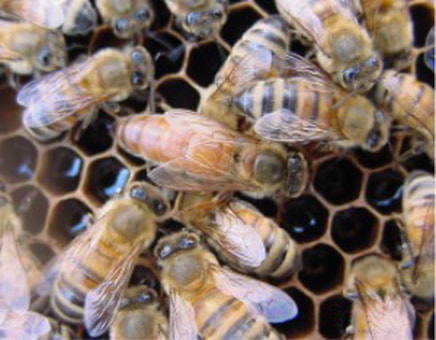 Any Any fertilized honey bee egg can become a queen bee. All larvae are fed royal jelly (a protein-rich substance secreted from a gland in the nurse bee’s head) for the first three days after the egg hatches. After 3 days, larvae chosen to become queens continue to be fed royal jelly while most female larvae start to be fed bee bread (a fermented mixture of pollen and honey) and will become worker bees. Brutal The queen bee does not “run” the hive, but she does somewhat control the actions of the workers through the pheromones she excretes. Queens emit many pheromones that let the workers know she is present and healthy. When the levels of queen pheromones she gives off goes down, the workers will supercede her (i.e. make a new queen). The workers will also make a new queen if the queen dies suddenly or when they are going to swarm. Typically, a hive will make many new queens to ensure the successful raising of a queen, and the first queen to eclose will find the other new queens (sometimes still in their cells) and sting them to death. Count There is usually only one queen in a hive. She is the largest bee because she has an abdomen full of eggs and sperm and is the only female able to lay fertilized eggs. A healthy queen can lay 3,000 eggs per day. About a week after emerging (eclosing), a virgin queen will leave the hive on one or more mating flights. On these flights she will mate with between 10 and 20 drones from other colonies. If the colony doesn't swarm, this is the only time the queen will ever leave the hive. More information: https://extension.psu.edu/an-introduction-to-queen-honey-bee-development 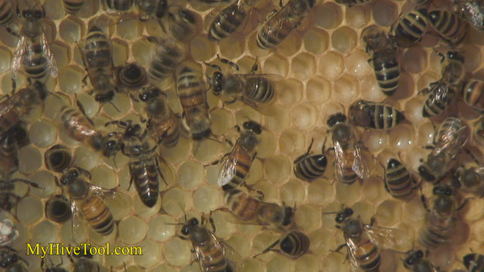 Appropriate Healthy bee brood is located in the “brood chamber” in the middle of the hive. These frames typically are either wall-to-wall capped brood (in spring or summer) or have brood in the middle, followed by a layer of pollen, with honey in the corners. A healthy brood pattern is solid, not spotty, and healthy larvae are plump, white grubs floating in large pools of white royal jelly. When the pupae are capped with wax, the caps are slightly raised and dark yellow without any perforations. The caps darken to tan as the pupae ages. Bad There are many bee brood diseases: sacbrood, chalkbrood, snotty brood, European Foulbrood, and American Foulbrood, etc. Varroa mites also feed on bee brood and replicate inside capped pupal cells. The most serious brood disease is American Foulbrood or AFB which is an extremely contagious, almost impossible to kill, and fatal disease in honey bees which may require you to burn your hive to control its spread. Signs of brood disease include (but are not limited to) spotty brood, twisted larvae, “skeletal” larvae, discolored larvae, pointy larvae, dry and mummified larvae, goopy larvae, sunken caps, discolored/caramel-colored caps, perforated caps, bald brood (pupae that have no caps), black scales inside of brood cells, a bad smell, and white crystals inside brood cells. Cycle The life cycle of all castes of bees is similar, but has a slightly different time scale. All bees are eggs for 3 days, and larvae for 6 days. The queen is then a pupae for only 6 or 7 more days (15-16 days total). The workers are pupae for 12 days (21 days total). The larger drones are pupae for 15 days (24 days total). The bees then emerge from their cells as fully-formed adults and do not grow any more. Queen = ~16 days from egg being laid to emergence (eclosure) from cell as an adult Worker = 21 days Drone = 24 days More Information: https://bee-health.extension.org/bee-brood-basic-bee-biology-for-beekeepers/ 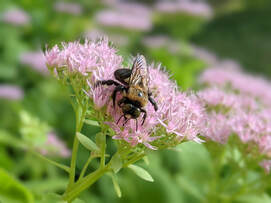 Apis mellifera Apis mellifera is the western honey bee. Its native range is Europe, Africa, and the Middle East. It is one of the only eusocial animal species on the planet, meaning that a colony of honey bees is a superorganism. No one individual bee can survive on its own. Bees There are over 16,000 species of bees in the world, about 4,000 of which are native to North America, and around 450 species of which are native to Michigan. Of those 16,000+ species, only around 8 species of bees produce honey. There are no native honey-producing bees in North America. Most bees are solitary bees and do not live in colonies. Castes Being a eusocial superorganism means that honey bees are divided into castes or physiologically different variations of the same species. The 3 honey bee castes are the queen, workers, and drones. The queen is the only fertile female in the colony and lays all the eggs. She is the largest bee in the hive. The workers are all sterile females who, as their name suggests, do all of the work inside and outside the hive including brood rearing, foraging for food, wax building, taking care of the queen, and many, many other tasks. The drones are the male bees. They are larger than the workers and their only job is to fertilize virgin queen bees. More Information: https://www.nwf.org/Educational-Resources/Wildlife-Guide/Invertebrates/Bees 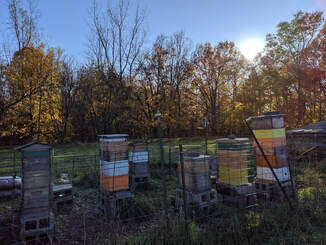 Artificial Honey bees are NOT NATIVE to North America. Therefore, there is no such thing as “natural beekeeping” in the United States when it comes to Apis mellifera. Beekeeping Beekeeping is less of a hobby and more of an agricultural undertaking. The USDA considers honey bees to be livestock. Care A honey bee colony is an ANIMAL! Think of it like a new puppy. It needs food, water, shelter, health care, and room to grow. It is not something that you can set up and walk away from to let the honey bees “do their thing.” Not managing your colonies is animal neglect. More Information: https://www.nal.usda.gov/legacy/afsic/beekeeping |
AuthorJen Haeger is a new master beekeeper and board member of A2B2. Archives
August 2022
Categories
All
|

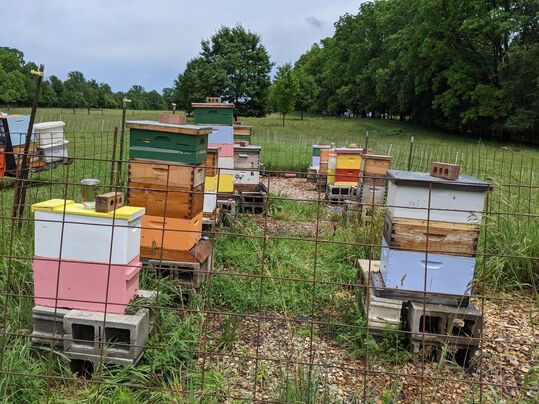
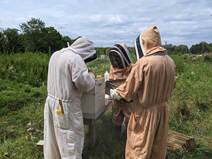
 RSS Feed
RSS Feed
